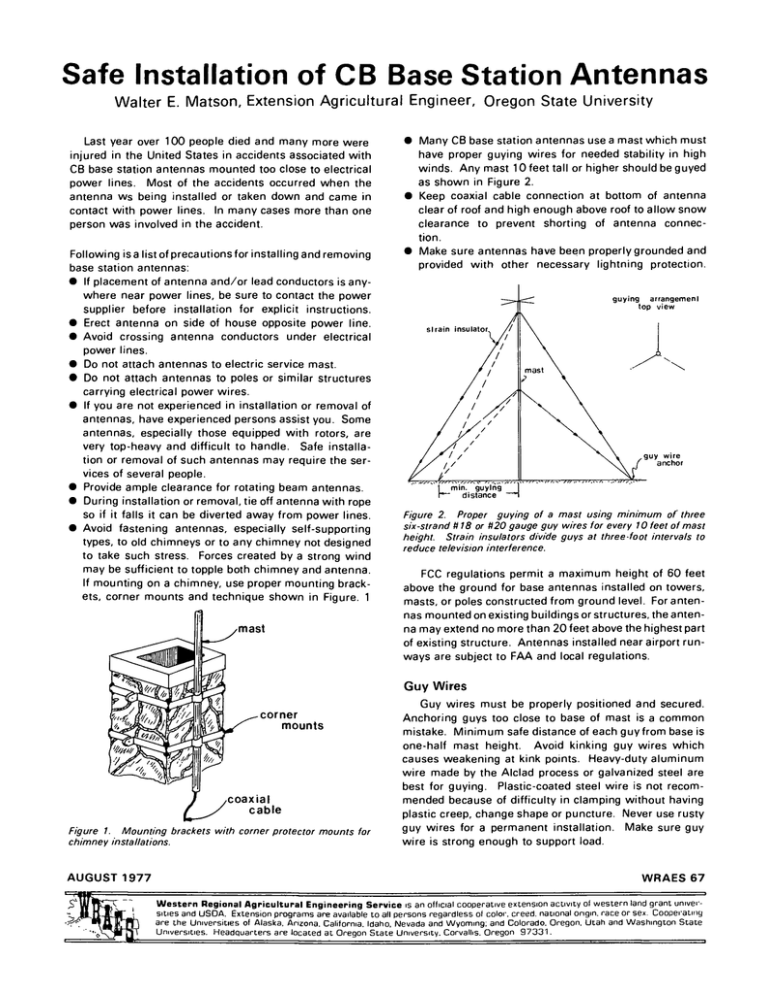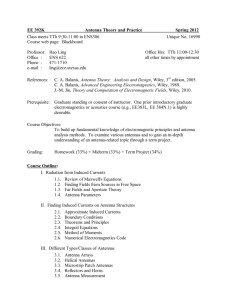CB Antenna Installation Safety Guide
advertisement

Safe Installation of CB Base Station Antennas Walter E. Matson, Extension Agricultural Engineer, Oregon State University Last year over 100 people died and many more were injured in the United States in accidents associated with CB base station antennas mounted too close to electrical power lines. Most of the accidents occurred when the antenna ws being installed or taken down and came in contact with power lines. In many cases more than one person was involved in the accident. Following is a list of precautions for installing and removing base station antennas: • If placement of antenna and/or lead conductors is anywhere near power lines, be sure to contact the power supplier before installation for explicit instructions. • Erect antenna on side of house opposite power line. • Avoid crossing antenna conductors under electrical power lines. • Do not attach antennas to electric service mast. • Do not attach antennas to poles or similar structures carrying electrical power wires. • If you are not experienced in installation or removal of antennas, have experienced persons assist you. Some antennas, especially those equipped with rotors, are very top-heavy and difficult to handle. Safe installation or removal of such antennas may require the services of several people. • Provide ample clearance for rotating beam antennas. • During installation or removal, tie off antenna with rope so if it falls it can be diverted away from power lines. • Avoid fastening antennas, especially self-supporting types, to old chimneys or to any chimney not designed to take such stress. Forces created by a strong wind may be sufficient to topple both chimney and antenna. If mounting on a chimney, use proper mounting brackets, corner mounts and technique shown in Figure. 1 mast Many CB base station antennas use a mast which must have proper guying wires for needed stability in high winds. Any mast 10 feet tall or higher should be guyed as shown in Figure 2. Keep coaxial cable connection at bottom of antenna clear of roof and high enough above roof to allow snow clearance to prevent shorting of antenna connection. Make sure antennas have been properly grounded and provided with other necessary lightning protection. guying arrangement top view strain insulator. guy wire anchor I min. guying r~ distance " Figure 2. Proper guying of a mast using minimum of three six-strand # 18 or #20 gauge guy wires for every 10 feet of mast height. Strain insulators divide guys at three-foot intervals to reduce television interference. FCC regulations permit a maximum height of 60 feet above the ground for base antennas installed on towers, masts, or poles constructed from ground level. For antennas mounted on existing buildings or structures, the antenna may extend no more than 20 feet above the highest part of existing structure. Antennas installed near airport runways are subject to FAA and local regulations. Guy Wires corner mounts coaxial cable Figure 1. Mounting brackets with corner protector mounts for chimney installations. AUGUST 1977 Guy wires must be properly positioned and secured. Anchoring guys too close to base of mast is a common mistake. Minimum safe distance of each guy from base is one-half mast height. Avoid kinking guy wires which causes weakening at kink points. Heavy-duty aluminum wire made by the Alclad process or galvanized steel are best for guying. Plastic-coated steel wire is not recommended because of difficulty in clamping without having plastic creep, change shape or puncture. Never use rusty guy wires for a permanent installation. Make sure guy wire is strong enough to support load. WRAES 67 Western Regional Agricultural Engineering Service is an official cooperative extension activity of western land grant universities and USOA. Extension programs are available to all persons regardless of color, creed, national origin, race or sex. Cooperating are the Universities of Alaska, Arizona, California. Idaho, Nevada and Wyoming; and Colorado. Oregon. Utah and Washington State Universities. Headquarters are located at Oregon State University. Corvallis. Oregon 97331. Radio frequency radiation from guy wires which causes TV interference, especially on channel 2, can be reduced by dividing continuous lengths of guy wire into segments, each no longer than 3 feet, using strain insulators between segments as shown in Figure 2. Install proper anchors and securely fasten guy wires to anchors. Screw eye anchors are generally used on wooden structures. Fasten them to something solid such as structural f raming--not to roof shingles or siding. Screw anchor down as far as possible and securely fasten guy wire as shown in Figure 3. Use a grooved metal thimble that can be slipped through anchor eye and fit inside wire loop to prevent kinks and possible weakening. Use a turnbuckle on each guy wire to keep guy wires properly adjusted. split or U-bolt fastener grooved metal thimble turnbuckle eye screw anchor Figure 4. Antenna, mast and coaxial cable must be grounded against lightning. Connect lightning arrester in coaxial cable between antenna and transceiver. Bond arrester grounding terminal to mast with #72 wire through positive connector clamp. Ground mast with U6 copper wire, making no sharp bends between mast and grounding attachment. Figure 3. Anchors should be properly secured in structural member. Use metal thimble and split bolt fasteners to secure guys to anchors and turnbuckle eyes. Offset each set of guys with separate anchor ties for maximum stability. Lightning Protection Lightning follows the path of least resistance to ground. The antenna often provides that path. Therefore, the antenna mast and coaxial cable must be properly grounded to provide a direct path through which lightning can be brought to earth safely as shown in Figure 4. Without such grounding, CB equipment could be ruined, perhaps a fire started or injury or even death inflicted to occupants of the structure or users of CB equipment. A lightning arrester or static discharge device should always be connected in the coaxial cable between antenna and transceiver to provide a bypass for high voltage discharges to ground. It should be installed at the antenna end of the coaxial cable near the mast base. Use a #12 or larger American Wire Gauge (AWG) wire to bond arrester grounding terminal to antenna mast, using a positive connection grounding clamp to fasten to mast. The antenna mast should be connected to ground with copper wire of at least #6 gauge, and fastened securely at both ends with positive connection grounding clamps. The mast grounding conductor must be run through stand-off insulators in as direct a line as possible with no sharp bends from the mast to the grounding rod or electrode. A good earth ground is required. A positive method of grounding is an 8-foot grounding rod of Vs-inch steel, V2inch non-ferrous rod, or %-inch galvanized pipe driven into the ground. If water lines are not plastic, the water system can also provide a good point of grounding. When using a water system as a ground, be sure the metal water piping does go underground and that any water meter is properly bonded to provide adequate grounding. Neither grounding nor lightning arresters can prevent lightning from striking an antenna. And even with good grounding, some high-voltage current may still continue down the coaxial cable to the CB set. Therefore, it is good practice to disconnect the antenna lead from the transceiver when an electrical storm approaches. When doing so, be sure to unplug set and tag front of set or microphone with a prominent warning-DO NOT OPERATE--ANTENNA DISCONNECTED -to prevent someone from keying the microphone and blowing out the final stage of transmitter due to no antenna connection. CAUTION--Whenever working on building roofs to install or adjust antennas, follow these safety precautions: 1. Wear insulated gloves and sturdy work shoes, preferably high top or boot, tightly laced with non-skid rubber soles and heels 2. Use wooden ladder that extends several feet above point where you'll step off onto roof 3. Never try to set ladder on roof top to assemble or adjust antenna 4. Watch out for overhead power lines 5. Whenever handling a CB base antenna, LOOKUPAND LOOK OUT! Additional information on lightning protection is available in USDA Farmers' Bulletin No. 2136 entitled "Lightning Protection for the Farm" available from your local Extension Service. This leaflet is based on manuscript originally prepared and approved for publication by Extension Service, Oregon State University.

![EEE 443 Antennas for Wireless Communications (3) [S]](http://s3.studylib.net/store/data/008888255_1-6e942a081653d05c33fa53deefb4441a-300x300.png)
